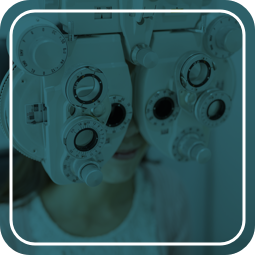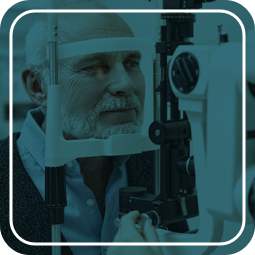When switching from glasses to contact lenses, many people assume that glasses prescriptions are the same as contact lens prescriptions. After all, they’re going onto the same eyes, right?
However, glasses and contact lens prescriptions aren’t the same. Glasses and contact lenses have to be prescribed differently because of how one sits on your face vs. directly on your eyes. A comprehensive eye exam can establish your glasses prescription, but contact lenses require a separate exam and fitting process to make sure that they’re worn correctly.
Understanding Eyeglass Prescriptions
Eyeglass prescriptions are designed specifically for lenses that sit about 12 millimeters away from your eyes. This distance, known as the vertex distance, can affect how light is bent before it reaches your eyes. Therefore, the power required to correct your vision for glasses will be different compared to the power needed for contact lenses, which sit directly on the cornea.
Key Components of Eyeglass Prescriptions
- Sphere (SPH): Indicates the lens power needed to correct nearsightedness (minus sign) or farsightedness (plus sign).
- Cylinder (CYL) and Axis: These values address astigmatism, measuring the degree and orientation of the curvature of the eye.
- Add Power: Only included or taken into account for prescriptions designed for readers, bifocals andmultifocals, as it corrects presbyopia by adding magnifying power for close-up work.
Understanding Contact Lens Prescriptions
Unlike eyeglass lenses, contact lenses rest directly on the surface of your eyes. This proximity changes how the lenses interact with the curvature of your cornea and the tear film. Consequently, contact lens prescriptions include additional parameters to ensure a proper fit and optimal vision correction.
Key Components of Contact Lens Prescriptions
- Base Curve (BC) and Diameter (DIA): These measurements ensure that the contact lens fits comfortably and stays centered on your eye.
- Brand: Specific brands and types of contact lenses are often listed because materials and designs vary significantly between products.
- Power (PWR) or Sphere (SPH): Similar to eyeglass prescriptions, this indicates the corrective power of the lens; however, it can vary as it needs to account for the lack of vertex distance and bending of a soft lens may take when sitting on a steeper or flatter than average eye.
- Cylinder (CYL) and Axis: Used for toric lenses, these values correct astigmatism or the distortion created by a soft lens molding to an irregularly shaped eye.
Why Are They Different?
The primary reason for the difference is the vertex distance—the space between the front surface of the eye and the back surface of the eyeglass lens. Contact lenses eliminate this distance, requiring adjustments in lens power. Additionally, contact lenses need to account for the curvature of the eye and must fit snugly to avoid discomfort or movement that could blur vision.
Vertex Distance & Lens Power
When glasses correct vision, they do so from a slight distance away from the eye. This distance can affect the lens power required to focus light correctly onto the retina. Contact lenses, on the other hand, sit directly on the cornea, meaning the power calculation must be adjusted to account for this difference in distance.
Fitting Considerations
Contact lenses require precise fitting to match the curvature of your eye. This ensures comfort and clarity, preventing issues like lens slippage or irritation. The base curve and diameter specifications in a contact lens prescription are crucial for achieving this fit. In certain situations, flexure or soft lens molding can occur. Since soft lenses are typically malleable, they take the shape of the eye surface (primarily the cornea). Flexure takes place when the corneal curvatures are sufficiently different from the soft lens curvatures. This mismatch is typically found with patients with steeper or flatter than average corneal curvatures, or in those that have astigmatism. Flexure essentially bends and distorts the shape of the contact lens and the optics as light moves through the contact lens. This can create blurred vision that can be detected by your optometrist.
This potential distortion can be predicted at the start of your contact lens fitting; however, the best way to measure the amount of blur is by having your optometrist measure your vision with the lenses on your eyes. In some cases, flexure and curvature mismatches are too large and hard contact lenses (RGP, scleral, Hybrid lenses) are needed to provide clear vision for those individuals.
There are a few options to correct presbyopia using contact lenses. The two main strategies include the use of multifocal contact lenses and monovision. These strategies are not used in glasses since we can look through different parts of the glasses (top vs bottom) or easily switch from one pair to the other should we want more power for reading versus when we are looking in the distance. Contact lenses follow our eye movements and they are not easily removed and reinserted when switching between tasks.
Multifocal contact lenses, for instance, uses gradient of powers across the lens to extend our range of focus that we gradually lose with age. The advantage of this strategy is to keep both eyes focused on your target to provide more natural vision and to optimize our depth perception. The challenge with the current technology is an overall decline in clear vision as a trade off. New designs are working to improve this trade off and provide improved quality of vision with these lenses. In order to know if this trade off works for you, give these lenses a try for yourself.
The other common strategy is monovision where one eye is set to focus in the distance and the other eye is focused at near. While both eyes are open, your brain is able to choose which eye is seeing your target clearest and automatically takes priority. This strategy is similar to how the monocle was used in the past. There are some challenges as your optometrist will need to determine the range of focus you need and what your visual system will allow. As you need more range (far to near) of focus, the difference in focus between the eyes will increase. If not fit properly, this can cause a decline in depth perception, balance and clarity of vision. That said, this has been a successful strategy for many years and is commonly preferred over the multifocal option.
For new contact lens prescriptions, presbyopic lens wearers, or large changes in an existing prescription, your optometrist will normally require follow-up appointments to confirm that the contact lenses are working as intended. If needed, your optometrist can then make adjustments to the contact lens prescription to get the best possible results.
Extra Requirements for Contact Lenses
Your optometrist’s professional association (such as the College of Optometrists of Ontario) may also have extra rules for them to follow when it comes to fitting contact lenses.
- Insertion, Removal, and Lens Care: The College of Optometrists of Ontario requires that optometrists ensure their patients can insert, remove, and properly care for their lenses. This will be a special fitting appointment with your optometrist or designated staff members to teach you how to handle your lenses at home.
- Eye Exam Confirmation: For patients arriving from out of province, the College of Optometrists of Ontario requires that the patient has a glasses prescription on file with an Ontario optometrist before they can issue a contact lens prescription. This is done to make sure that you’ve received proper medical care, including a comprehensive eye exam, so that the contact lens prescription is based on accurate information about your eye health.
Importance of Professional Fittings
Whether you wear glasses or contact lenses, it’s essential to get professional fittings and regular eye exams. An optometrist can provide accurate prescriptions tailored to your unique vision needs and ensure both your glasses and contacts fit comfortably and work effectively.
Understand Your Options with Downtown Eye Care & The Contact Lens Department
Understanding the differences between eyeglass and contact lens prescriptions can help you make informed decisions about your eye care. Both types of prescriptions are tailored to their specific use cases, ensuring you receive the best possible vision correction.If you’re considering switching from glasses to contact lenses or vice versa, book an appointment with Downtown Eye Care & The Contact Lens Department. We can guide you through the process, provide accurate prescriptions, and ensure you achieve optimal vision and comfort.















